Leadership and Management in Operations: A Tesco Case Study Report
VerifiedAdded on 2020/10/22
|16
|5205
|238
Report
AI Summary
This report provides a detailed analysis of leadership and management practices within Tesco, a major retail company. It begins by defining and comparing the roles and characteristics of leaders and managers, differentiating between them through various theories and concepts. The report examines situational leadership, exploring how leaders and managers function in different situations, and delves into various leadership theories and models, including situational, system, contingency, and action-centered theories. It then evaluates the strengths and weaknesses of different management approaches, analyzes key approaches to operations management, and assesses the importance of operations management in achieving business objectives. Furthermore, the report considers the factors of the business environment that affect operations management and decision-making by leaders and managers. Finally, it discusses the application of operations management within the organization and factors that impact the business environment, concluding with insights into how leaders and managers can improve efficiency and address challenges.
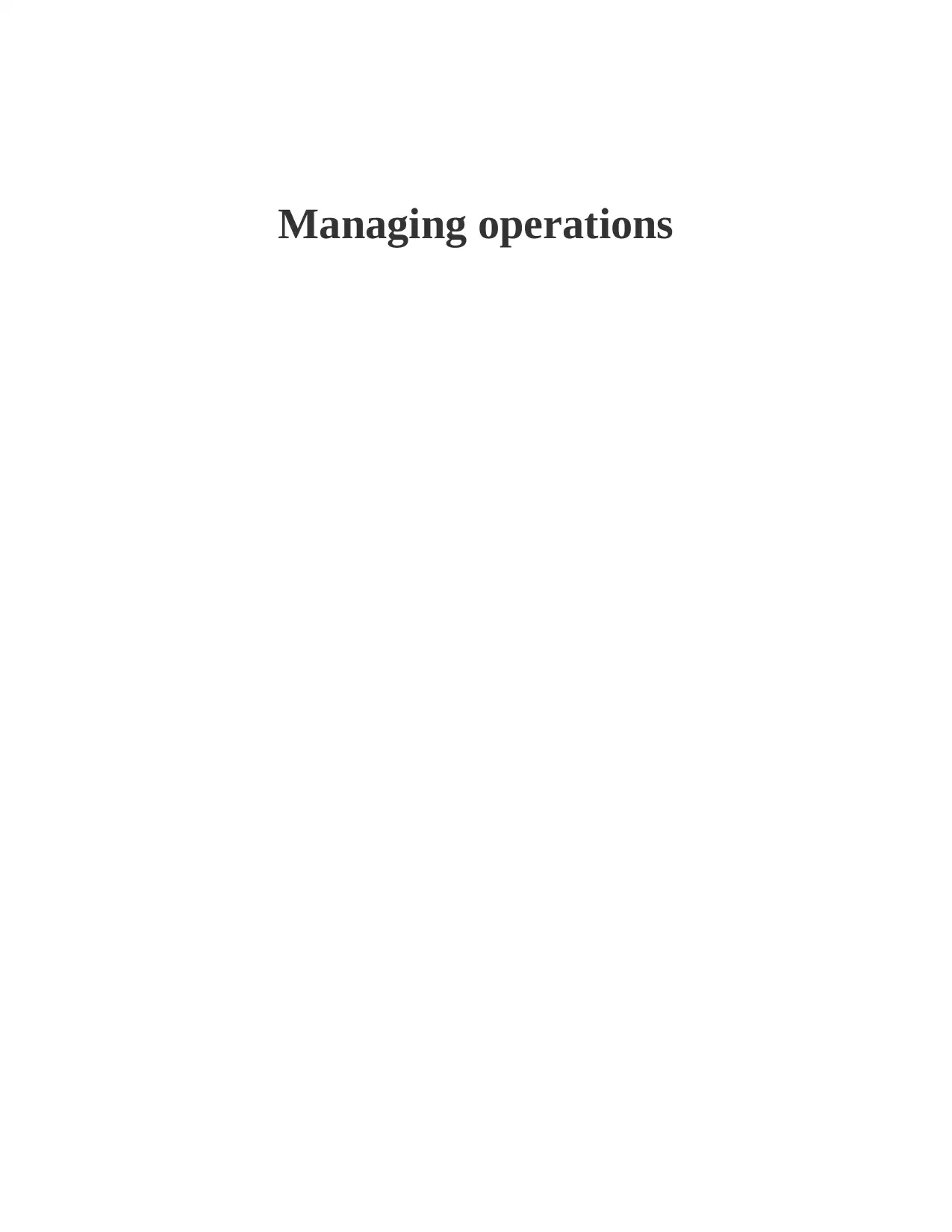
Managing operations
Paraphrase This Document
Need a fresh take? Get an instant paraphrase of this document with our AI Paraphraser
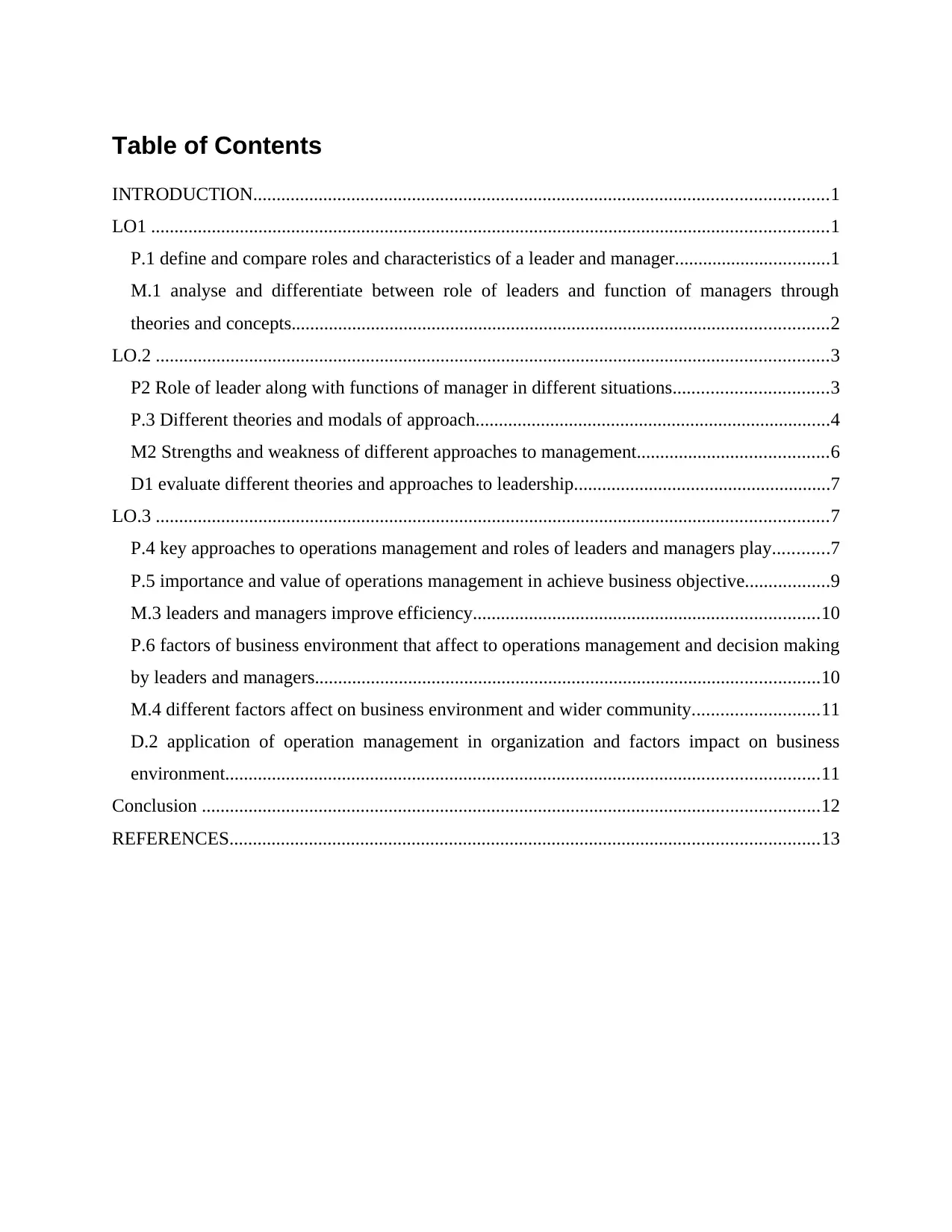
Table of Contents
INTRODUCTION...........................................................................................................................1
LO1 .................................................................................................................................................1
P.1 define and compare roles and characteristics of a leader and manager.................................1
M.1 analyse and differentiate between role of leaders and function of managers through
theories and concepts...................................................................................................................2
LO.2 ................................................................................................................................................3
P2 Role of leader along with functions of manager in different situations.................................3
P.3 Different theories and modals of approach............................................................................4
M2 Strengths and weakness of different approaches to management.........................................6
D1 evaluate different theories and approaches to leadership.......................................................7
LO.3 ................................................................................................................................................7
P.4 key approaches to operations management and roles of leaders and managers play............7
P.5 importance and value of operations management in achieve business objective..................9
M.3 leaders and managers improve efficiency..........................................................................10
P.6 factors of business environment that affect to operations management and decision making
by leaders and managers............................................................................................................10
M.4 different factors affect on business environment and wider community...........................11
D.2 application of operation management in organization and factors impact on business
environment...............................................................................................................................11
Conclusion ....................................................................................................................................12
REFERENCES..............................................................................................................................13
INTRODUCTION...........................................................................................................................1
LO1 .................................................................................................................................................1
P.1 define and compare roles and characteristics of a leader and manager.................................1
M.1 analyse and differentiate between role of leaders and function of managers through
theories and concepts...................................................................................................................2
LO.2 ................................................................................................................................................3
P2 Role of leader along with functions of manager in different situations.................................3
P.3 Different theories and modals of approach............................................................................4
M2 Strengths and weakness of different approaches to management.........................................6
D1 evaluate different theories and approaches to leadership.......................................................7
LO.3 ................................................................................................................................................7
P.4 key approaches to operations management and roles of leaders and managers play............7
P.5 importance and value of operations management in achieve business objective..................9
M.3 leaders and managers improve efficiency..........................................................................10
P.6 factors of business environment that affect to operations management and decision making
by leaders and managers............................................................................................................10
M.4 different factors affect on business environment and wider community...........................11
D.2 application of operation management in organization and factors impact on business
environment...............................................................................................................................11
Conclusion ....................................................................................................................................12
REFERENCES..............................................................................................................................13
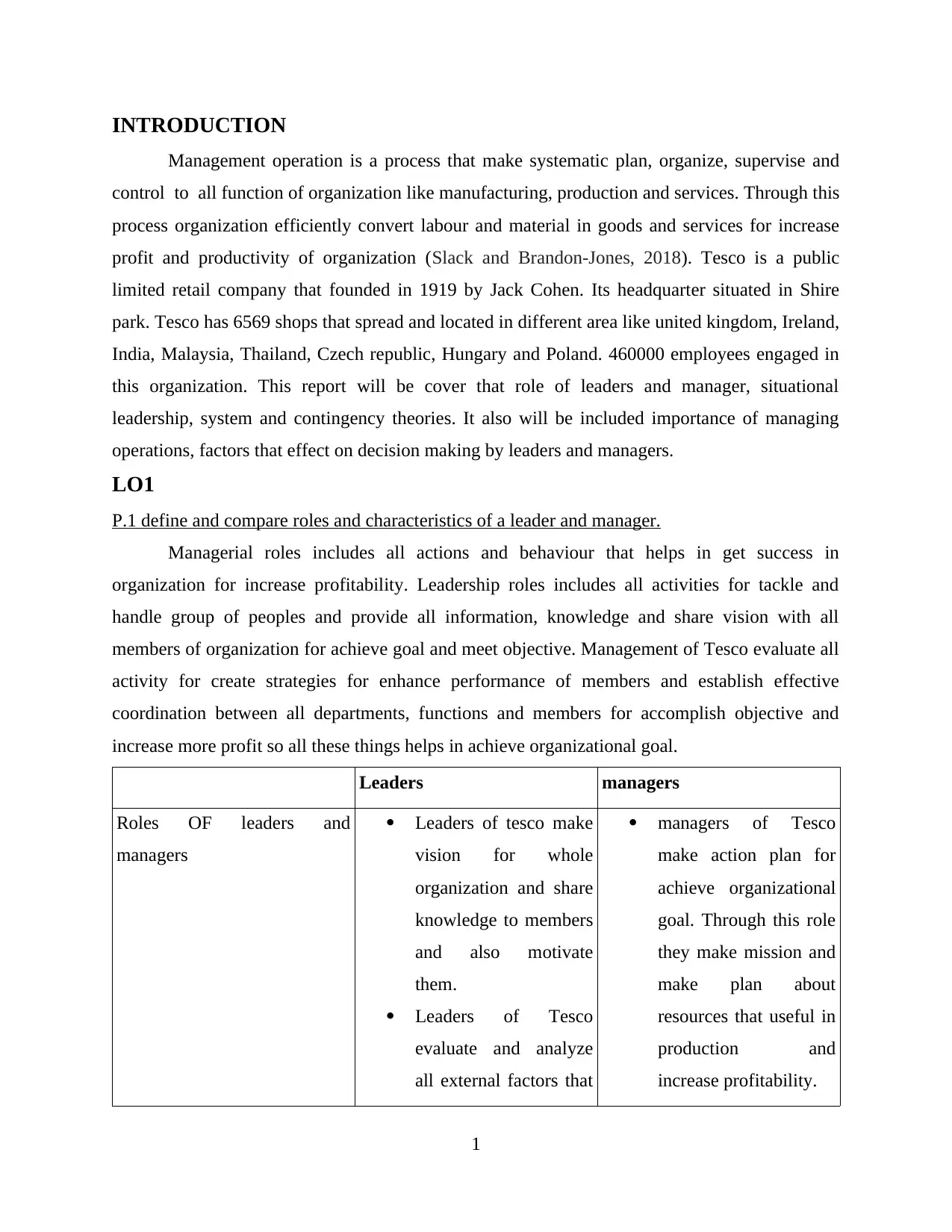
INTRODUCTION
Management operation is a process that make systematic plan, organize, supervise and
control to all function of organization like manufacturing, production and services. Through this
process organization efficiently convert labour and material in goods and services for increase
profit and productivity of organization (Slack and Brandon-Jones, 2018). Tesco is a public
limited retail company that founded in 1919 by Jack Cohen. Its headquarter situated in Shire
park. Tesco has 6569 shops that spread and located in different area like united kingdom, Ireland,
India, Malaysia, Thailand, Czech republic, Hungary and Poland. 460000 employees engaged in
this organization. This report will be cover that role of leaders and manager, situational
leadership, system and contingency theories. It also will be included importance of managing
operations, factors that effect on decision making by leaders and managers.
LO1
P.1 define and compare roles and characteristics of a leader and manager.
Managerial roles includes all actions and behaviour that helps in get success in
organization for increase profitability. Leadership roles includes all activities for tackle and
handle group of peoples and provide all information, knowledge and share vision with all
members of organization for achieve goal and meet objective. Management of Tesco evaluate all
activity for create strategies for enhance performance of members and establish effective
coordination between all departments, functions and members for accomplish objective and
increase more profit so all these things helps in achieve organizational goal.
Leaders managers
Roles OF leaders and
managers
Leaders of tesco make
vision for whole
organization and share
knowledge to members
and also motivate
them.
Leaders of Tesco
evaluate and analyze
all external factors that
managers of Tesco
make action plan for
achieve organizational
goal. Through this role
they make mission and
make plan about
resources that useful in
production and
increase profitability.
1
Management operation is a process that make systematic plan, organize, supervise and
control to all function of organization like manufacturing, production and services. Through this
process organization efficiently convert labour and material in goods and services for increase
profit and productivity of organization (Slack and Brandon-Jones, 2018). Tesco is a public
limited retail company that founded in 1919 by Jack Cohen. Its headquarter situated in Shire
park. Tesco has 6569 shops that spread and located in different area like united kingdom, Ireland,
India, Malaysia, Thailand, Czech republic, Hungary and Poland. 460000 employees engaged in
this organization. This report will be cover that role of leaders and manager, situational
leadership, system and contingency theories. It also will be included importance of managing
operations, factors that effect on decision making by leaders and managers.
LO1
P.1 define and compare roles and characteristics of a leader and manager.
Managerial roles includes all actions and behaviour that helps in get success in
organization for increase profitability. Leadership roles includes all activities for tackle and
handle group of peoples and provide all information, knowledge and share vision with all
members of organization for achieve goal and meet objective. Management of Tesco evaluate all
activity for create strategies for enhance performance of members and establish effective
coordination between all departments, functions and members for accomplish objective and
increase more profit so all these things helps in achieve organizational goal.
Leaders managers
Roles OF leaders and
managers
Leaders of tesco make
vision for whole
organization and share
knowledge to members
and also motivate
them.
Leaders of Tesco
evaluate and analyze
all external factors that
managers of Tesco
make action plan for
achieve organizational
goal. Through this role
they make mission and
make plan about
resources that useful in
production and
increase profitability.
1
⊘ This is a preview!⊘
Do you want full access?
Subscribe today to unlock all pages.

Trusted by 1+ million students worldwide
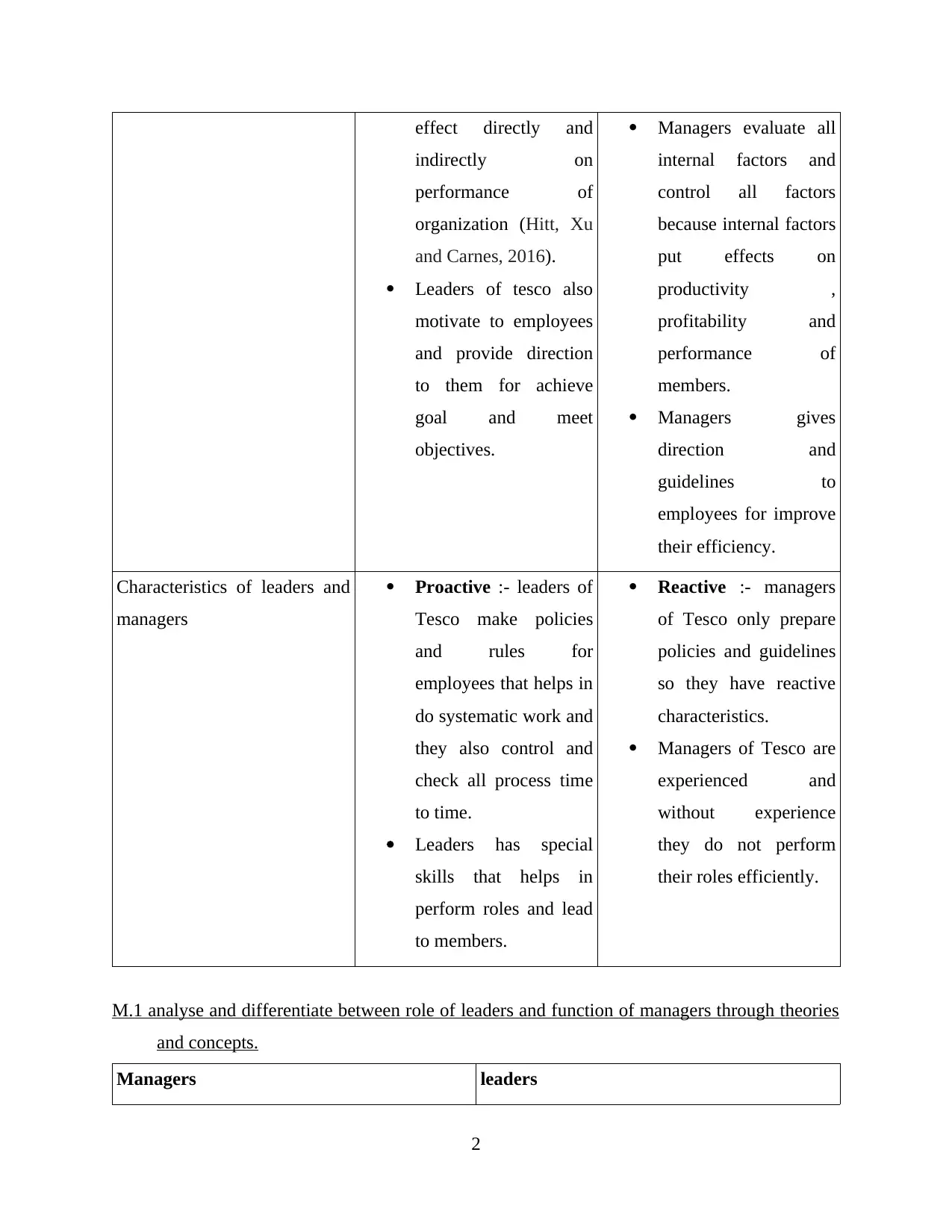
effect directly and
indirectly on
performance of
organization (Hitt, Xu
and Carnes, 2016).
Leaders of tesco also
motivate to employees
and provide direction
to them for achieve
goal and meet
objectives.
Managers evaluate all
internal factors and
control all factors
because internal factors
put effects on
productivity ,
profitability and
performance of
members.
Managers gives
direction and
guidelines to
employees for improve
their efficiency.
Characteristics of leaders and
managers
Proactive :- leaders of
Tesco make policies
and rules for
employees that helps in
do systematic work and
they also control and
check all process time
to time.
Leaders has special
skills that helps in
perform roles and lead
to members.
Reactive :- managers
of Tesco only prepare
policies and guidelines
so they have reactive
characteristics.
Managers of Tesco are
experienced and
without experience
they do not perform
their roles efficiently.
M.1 analyse and differentiate between role of leaders and function of managers through theories
and concepts.
Managers leaders
2
indirectly on
performance of
organization (Hitt, Xu
and Carnes, 2016).
Leaders of tesco also
motivate to employees
and provide direction
to them for achieve
goal and meet
objectives.
Managers evaluate all
internal factors and
control all factors
because internal factors
put effects on
productivity ,
profitability and
performance of
members.
Managers gives
direction and
guidelines to
employees for improve
their efficiency.
Characteristics of leaders and
managers
Proactive :- leaders of
Tesco make policies
and rules for
employees that helps in
do systematic work and
they also control and
check all process time
to time.
Leaders has special
skills that helps in
perform roles and lead
to members.
Reactive :- managers
of Tesco only prepare
policies and guidelines
so they have reactive
characteristics.
Managers of Tesco are
experienced and
without experience
they do not perform
their roles efficiently.
M.1 analyse and differentiate between role of leaders and function of managers through theories
and concepts.
Managers leaders
2
Paraphrase This Document
Need a fresh take? Get an instant paraphrase of this document with our AI Paraphraser
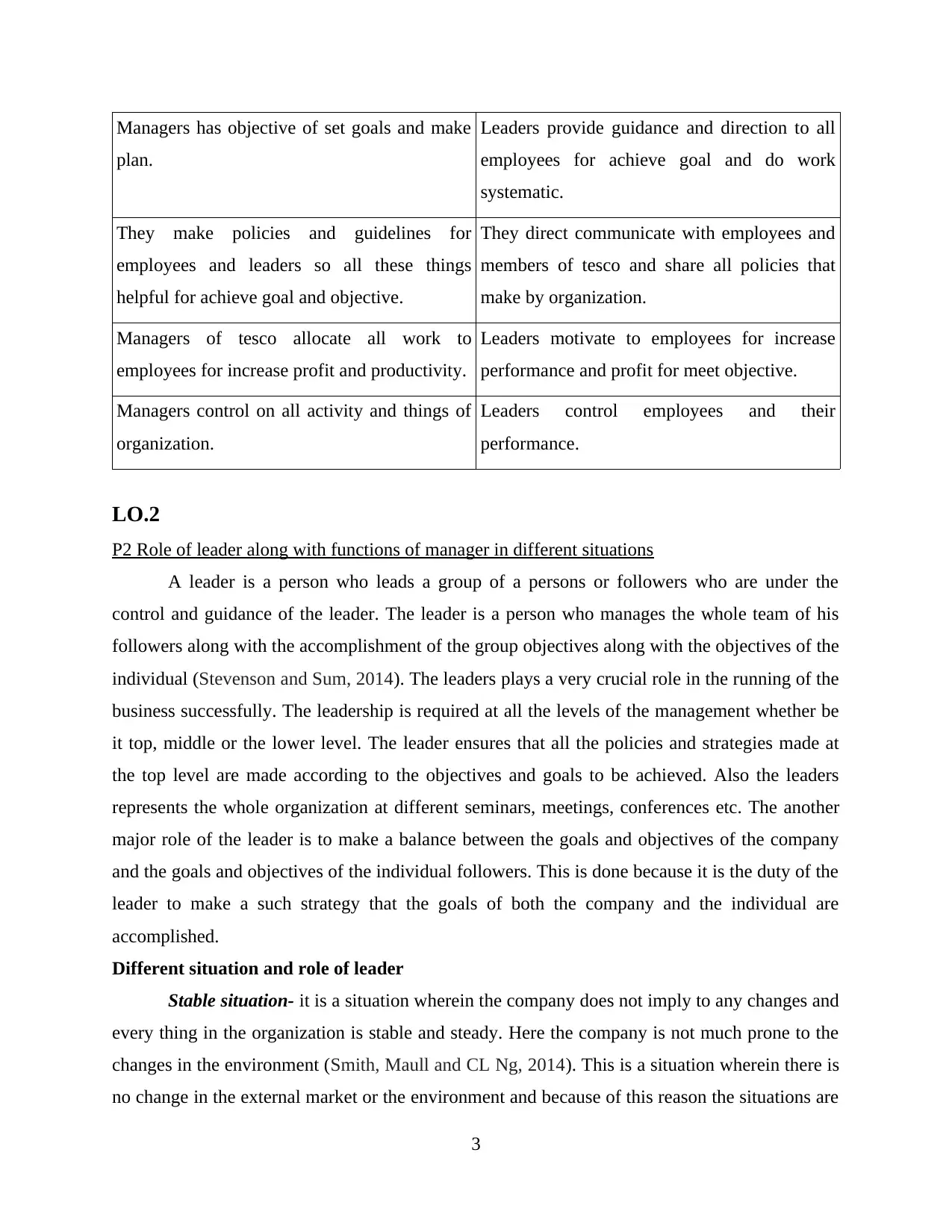
Managers has objective of set goals and make
plan.
Leaders provide guidance and direction to all
employees for achieve goal and do work
systematic.
They make policies and guidelines for
employees and leaders so all these things
helpful for achieve goal and objective.
They direct communicate with employees and
members of tesco and share all policies that
make by organization.
Managers of tesco allocate all work to
employees for increase profit and productivity.
Leaders motivate to employees for increase
performance and profit for meet objective.
Managers control on all activity and things of
organization.
Leaders control employees and their
performance.
LO.2
P2 Role of leader along with functions of manager in different situations
A leader is a person who leads a group of a persons or followers who are under the
control and guidance of the leader. The leader is a person who manages the whole team of his
followers along with the accomplishment of the group objectives along with the objectives of the
individual (Stevenson and Sum, 2014). The leaders plays a very crucial role in the running of the
business successfully. The leadership is required at all the levels of the management whether be
it top, middle or the lower level. The leader ensures that all the policies and strategies made at
the top level are made according to the objectives and goals to be achieved. Also the leaders
represents the whole organization at different seminars, meetings, conferences etc. The another
major role of the leader is to make a balance between the goals and objectives of the company
and the goals and objectives of the individual followers. This is done because it is the duty of the
leader to make a such strategy that the goals of both the company and the individual are
accomplished.
Different situation and role of leader
Stable situation- it is a situation wherein the company does not imply to any changes and
every thing in the organization is stable and steady. Here the company is not much prone to the
changes in the environment (Smith, Maull and CL Ng, 2014). This is a situation wherein there is
no change in the external market or the environment and because of this reason the situations are
3
plan.
Leaders provide guidance and direction to all
employees for achieve goal and do work
systematic.
They make policies and guidelines for
employees and leaders so all these things
helpful for achieve goal and objective.
They direct communicate with employees and
members of tesco and share all policies that
make by organization.
Managers of tesco allocate all work to
employees for increase profit and productivity.
Leaders motivate to employees for increase
performance and profit for meet objective.
Managers control on all activity and things of
organization.
Leaders control employees and their
performance.
LO.2
P2 Role of leader along with functions of manager in different situations
A leader is a person who leads a group of a persons or followers who are under the
control and guidance of the leader. The leader is a person who manages the whole team of his
followers along with the accomplishment of the group objectives along with the objectives of the
individual (Stevenson and Sum, 2014). The leaders plays a very crucial role in the running of the
business successfully. The leadership is required at all the levels of the management whether be
it top, middle or the lower level. The leader ensures that all the policies and strategies made at
the top level are made according to the objectives and goals to be achieved. Also the leaders
represents the whole organization at different seminars, meetings, conferences etc. The another
major role of the leader is to make a balance between the goals and objectives of the company
and the goals and objectives of the individual followers. This is done because it is the duty of the
leader to make a such strategy that the goals of both the company and the individual are
accomplished.
Different situation and role of leader
Stable situation- it is a situation wherein the company does not imply to any changes and
every thing in the organization is stable and steady. Here the company is not much prone to the
changes in the environment (Smith, Maull and CL Ng, 2014). This is a situation wherein there is
no change in the external market or the environment and because of this reason the situations are
3

stable in the organization. If the situations are stable then the leader do not have a specific role to
play. It has to perform his general duties.
Slow to moderate changing situation- it is a situation where the changes starts at a slow
pace and then takes speed. For example, the situation of the employee dissatisfaction. It is a
situation wherein the employees are unhappy or develops a negative feeling or perspective about
the work or the working environment (Hitt, Xu and Carnes, 2016). There are many factors which
may result in job dissatisfaction like overload of work, low pay, no scope of promotions, poor
working conditions etc. This feeling starts slowly and then takes up speed. If the leader has to
deals with such situation then he will first try to find the reason for which the employee is
dissatisfied whether the reason is personal, mental, psychological, related to the organisation etc.
After analysing the reason of dissatisfaction the leader tries to find the solution to the problem of
the dissatisfaction (Artto, Ahola and Vartiainen, 2016). Also leader tries to provide some
facilities and extra care to the dissatisfied employees so that they do not leave the organisation.
In the similar situation the manager might not ask the employee the reason for its dissatisfaction
rather may directly give a leave to the employee to solve the problem or might terminate him for
permanent.
Fast changing situation- it is a situation where in the change comes very fast and the
company needs to adapt to these changes very fast. If the company does not adapt to these
changes then it may be possible that the company may suffers loss. For example, changes in the
technology, these are the changes which comes very fast in the environment and if the company
does not adapt to these changes then it will be a loss for them (Simchi - Levi, Schmidt and Wei,
2014). In such case the leader will first analyse the need of change and if he feels the need of
change then it will train the employees to adapt those changes. On the other hand the manager
will simply impose the change on the employees.
P.3 Different theories and modals of approach.
Situational leadership :- through this theory, leaders of tesco provide coaching, support
and guidelines to employees and subordinates so these all things helps in achieve organization
goal and achieve success. This theory also helps in Tesco for increase morale o employees and
increase and improve skills and knowledge of them. Leaders of organization also adopt and
change different styles of leadership according to situation for handle. Following styles use by
Tesco for implement approach.
4
play. It has to perform his general duties.
Slow to moderate changing situation- it is a situation where the changes starts at a slow
pace and then takes speed. For example, the situation of the employee dissatisfaction. It is a
situation wherein the employees are unhappy or develops a negative feeling or perspective about
the work or the working environment (Hitt, Xu and Carnes, 2016). There are many factors which
may result in job dissatisfaction like overload of work, low pay, no scope of promotions, poor
working conditions etc. This feeling starts slowly and then takes up speed. If the leader has to
deals with such situation then he will first try to find the reason for which the employee is
dissatisfied whether the reason is personal, mental, psychological, related to the organisation etc.
After analysing the reason of dissatisfaction the leader tries to find the solution to the problem of
the dissatisfaction (Artto, Ahola and Vartiainen, 2016). Also leader tries to provide some
facilities and extra care to the dissatisfied employees so that they do not leave the organisation.
In the similar situation the manager might not ask the employee the reason for its dissatisfaction
rather may directly give a leave to the employee to solve the problem or might terminate him for
permanent.
Fast changing situation- it is a situation where in the change comes very fast and the
company needs to adapt to these changes very fast. If the company does not adapt to these
changes then it may be possible that the company may suffers loss. For example, changes in the
technology, these are the changes which comes very fast in the environment and if the company
does not adapt to these changes then it will be a loss for them (Simchi - Levi, Schmidt and Wei,
2014). In such case the leader will first analyse the need of change and if he feels the need of
change then it will train the employees to adapt those changes. On the other hand the manager
will simply impose the change on the employees.
P.3 Different theories and modals of approach.
Situational leadership :- through this theory, leaders of tesco provide coaching, support
and guidelines to employees and subordinates so these all things helps in achieve organization
goal and achieve success. This theory also helps in Tesco for increase morale o employees and
increase and improve skills and knowledge of them. Leaders of organization also adopt and
change different styles of leadership according to situation for handle. Following styles use by
Tesco for implement approach.
4
⊘ This is a preview!⊘
Do you want full access?
Subscribe today to unlock all pages.

Trusted by 1+ million students worldwide

Directing :- through this style leaders give and share complete information to employees and
members about all plan and policies for improve their performance and motivate to them.
Because they get helps in do work and this style helps in meet objective.
Coaching :- it is also a style of leadership for implement approaches according to situation so
they make decision and also evaluate all performance and activities of employees (Schönsleben,
2016). After evaluation they provide coaching to improve skills and knowledge for do work
effectively. This style very useful and important for unskilled and new employees.
Supporting :- leaders of tesco support to their employees through motivate them and increase
confidence level as well. All employees and members like old and new has need of support for
improve and influence work and increase profitability and productivity.
Delegating :- this style useful in make change according to feedback that means leaders of tesco
give feedback about employees according to their performance so they can make changes and
improve their mistakes.
System leadership :- this system useful in tesco for leaders because they create condition
through this theory for employees because they do work with potential and productively at all
levels. Tesco do business at global level and it has hierarchical structure so through this theory
leaders make effective environment where employees and member work at different level can
complete their task and performance and responsibility effectively and efficiently. So leaders
control all employees that they working at different level very effectively through this theory.
They also easily evaluate behavior of members about work. All these system helps in improve
condition, profit and productivity of tesco. This theory use in following situation like :-
conflict resolution :- through above leadership approach leaders of organization knows about all
situation and behavior of employees so they easily resolve problem and conflicts among
employees and subordinates. This approach helps in establish effective coordination.
Policy formation :- for formation of policy leaders of tesco use this approach for make models
and strategies for making changes in organization and increase performance and profitability. So
according to situation and performance leaders make changes and improve working condition.
Contingency leadership :- this approach means that employees and subordinates make
changes and adopt own ideas for resolve any situation so this theory useful for motivate and
increase knowledge about solve problem through own way. They also learn many things
according to situation. This theory also helps in maintain all situation and make different policies
5
members about all plan and policies for improve their performance and motivate to them.
Because they get helps in do work and this style helps in meet objective.
Coaching :- it is also a style of leadership for implement approaches according to situation so
they make decision and also evaluate all performance and activities of employees (Schönsleben,
2016). After evaluation they provide coaching to improve skills and knowledge for do work
effectively. This style very useful and important for unskilled and new employees.
Supporting :- leaders of tesco support to their employees through motivate them and increase
confidence level as well. All employees and members like old and new has need of support for
improve and influence work and increase profitability and productivity.
Delegating :- this style useful in make change according to feedback that means leaders of tesco
give feedback about employees according to their performance so they can make changes and
improve their mistakes.
System leadership :- this system useful in tesco for leaders because they create condition
through this theory for employees because they do work with potential and productively at all
levels. Tesco do business at global level and it has hierarchical structure so through this theory
leaders make effective environment where employees and member work at different level can
complete their task and performance and responsibility effectively and efficiently. So leaders
control all employees that they working at different level very effectively through this theory.
They also easily evaluate behavior of members about work. All these system helps in improve
condition, profit and productivity of tesco. This theory use in following situation like :-
conflict resolution :- through above leadership approach leaders of organization knows about all
situation and behavior of employees so they easily resolve problem and conflicts among
employees and subordinates. This approach helps in establish effective coordination.
Policy formation :- for formation of policy leaders of tesco use this approach for make models
and strategies for making changes in organization and increase performance and profitability. So
according to situation and performance leaders make changes and improve working condition.
Contingency leadership :- this approach means that employees and subordinates make
changes and adopt own ideas for resolve any situation so this theory useful for motivate and
increase knowledge about solve problem through own way. They also learn many things
according to situation. This theory also helps in maintain all situation and make different policies
5
Paraphrase This Document
Need a fresh take? Get an instant paraphrase of this document with our AI Paraphraser

so these also reduce conflicts. Members easily adapt decision for making changes and do work
efficiently and effectively.
Action centered theory :- it is also a model that means leaders of tesco encourage and
motivate employees. This theory also provide guidelines for leaders about manage and tackle to
members in effective and efficient manner (Kapadia, 2018). With the helps of this approach
organization easily achieve goals and meet objectives and they easily lead whole teams.
Transactional theory :- this theory of leadership, leaders of tesco motivate and
encourage all employees so it give task to members and after complete of task it evaluate and
analyze and then give rewards and punishment according to completion of task. All members of
organization does their work according to guidelines and also follow all instructions.
M2 Strengths and weakness of different approaches to management
Type of leadership Strength Weakness
Situational leadership The approach of situational
leadership is very flexible and
these leaders do not insist on
following specific rules and
regulations (Steers and
Nardon, 2014).
This type of leadership has a
main focus on accomplishing
the short term requirements
instead of meeting the long
term requirements.
System leadership These type of leader have
higher potential and ability to
influence the followers or the
group of people and the whole
team.
The major weakness of this
type of leadership is that it is
very time consuming process
to follow. Also some times the
leader has to take on the spot
and spontaneous decisions and
sometimes these decisions may
create problem because the
decisions are to be taken after
a deep analysis of the whole
matter (Doherty, Horne and
Wootton, 2014).
6
efficiently and effectively.
Action centered theory :- it is also a model that means leaders of tesco encourage and
motivate employees. This theory also provide guidelines for leaders about manage and tackle to
members in effective and efficient manner (Kapadia, 2018). With the helps of this approach
organization easily achieve goals and meet objectives and they easily lead whole teams.
Transactional theory :- this theory of leadership, leaders of tesco motivate and
encourage all employees so it give task to members and after complete of task it evaluate and
analyze and then give rewards and punishment according to completion of task. All members of
organization does their work according to guidelines and also follow all instructions.
M2 Strengths and weakness of different approaches to management
Type of leadership Strength Weakness
Situational leadership The approach of situational
leadership is very flexible and
these leaders do not insist on
following specific rules and
regulations (Steers and
Nardon, 2014).
This type of leadership has a
main focus on accomplishing
the short term requirements
instead of meeting the long
term requirements.
System leadership These type of leader have
higher potential and ability to
influence the followers or the
group of people and the whole
team.
The major weakness of this
type of leadership is that it is
very time consuming process
to follow. Also some times the
leader has to take on the spot
and spontaneous decisions and
sometimes these decisions may
create problem because the
decisions are to be taken after
a deep analysis of the whole
matter (Doherty, Horne and
Wootton, 2014).
6

Contingency leadership The major strength of this type
of leadership is that the use of
this leadership style is that it
helps the leader in designing
the organizational structure
and the climate and helps in
taking decisions (Snell,
Bohlander and Morris, 2015).
This approach is very reactive
in nature. It means that if the
situation is some what difficult
then it might be possible to
handle the situation by the
manager (Slack and Brandon -
Jones, 2018).
D1 evaluate different theories and approaches to leadership.
Interpersonal roles :- this roles of leaders includes three part like figurehead that
includes all duties and responsibility of leaders in symbolic way and all things are legals and
social in nature. Second part is leaders that include roles like good leaders that have knowledge
about build good team, motivate them and developing strong relationship between all them
(Swink, 2017). Last part is liaison so that means establish good and effective network outside of
office and maintain relation with outsiders for gather information.
Informational roles :- this roles also includes three part like monitor so that means
gather information about issues that affect organization . Second is disseminator so this includes
all information receive about internal and external sources and last is spokesperson so this
includes representing the tesco and provide information to outsiders.
Decisional roles :- this roles includes entrepreneur that means person that establish new
innovation and changes. Disturbance handler means take correct action in difficult situation.
Resource allocator also part of his roles so they responsible for time, equipment, funds and
human resource. It also focus on optimum utilization of resources.
LO.3
P.4 key approaches to operations management and roles of leaders and managers play.
Operations management is a important part of tesco because through this management
organization convert labor and material into goods and services. This management give
maximum contribution in increase profitability through optimum utilization of resources.
Lean approach :- this approach is a startup process that includes many things like business plan,
development and encourage searching of customers. Through this approach tesco improve their
7
of leadership is that the use of
this leadership style is that it
helps the leader in designing
the organizational structure
and the climate and helps in
taking decisions (Snell,
Bohlander and Morris, 2015).
This approach is very reactive
in nature. It means that if the
situation is some what difficult
then it might be possible to
handle the situation by the
manager (Slack and Brandon -
Jones, 2018).
D1 evaluate different theories and approaches to leadership.
Interpersonal roles :- this roles of leaders includes three part like figurehead that
includes all duties and responsibility of leaders in symbolic way and all things are legals and
social in nature. Second part is leaders that include roles like good leaders that have knowledge
about build good team, motivate them and developing strong relationship between all them
(Swink, 2017). Last part is liaison so that means establish good and effective network outside of
office and maintain relation with outsiders for gather information.
Informational roles :- this roles also includes three part like monitor so that means
gather information about issues that affect organization . Second is disseminator so this includes
all information receive about internal and external sources and last is spokesperson so this
includes representing the tesco and provide information to outsiders.
Decisional roles :- this roles includes entrepreneur that means person that establish new
innovation and changes. Disturbance handler means take correct action in difficult situation.
Resource allocator also part of his roles so they responsible for time, equipment, funds and
human resource. It also focus on optimum utilization of resources.
LO.3
P.4 key approaches to operations management and roles of leaders and managers play.
Operations management is a important part of tesco because through this management
organization convert labor and material into goods and services. This management give
maximum contribution in increase profitability through optimum utilization of resources.
Lean approach :- this approach is a startup process that includes many things like business plan,
development and encourage searching of customers. Through this approach tesco improve their
7
⊘ This is a preview!⊘
Do you want full access?
Subscribe today to unlock all pages.

Trusted by 1+ million students worldwide
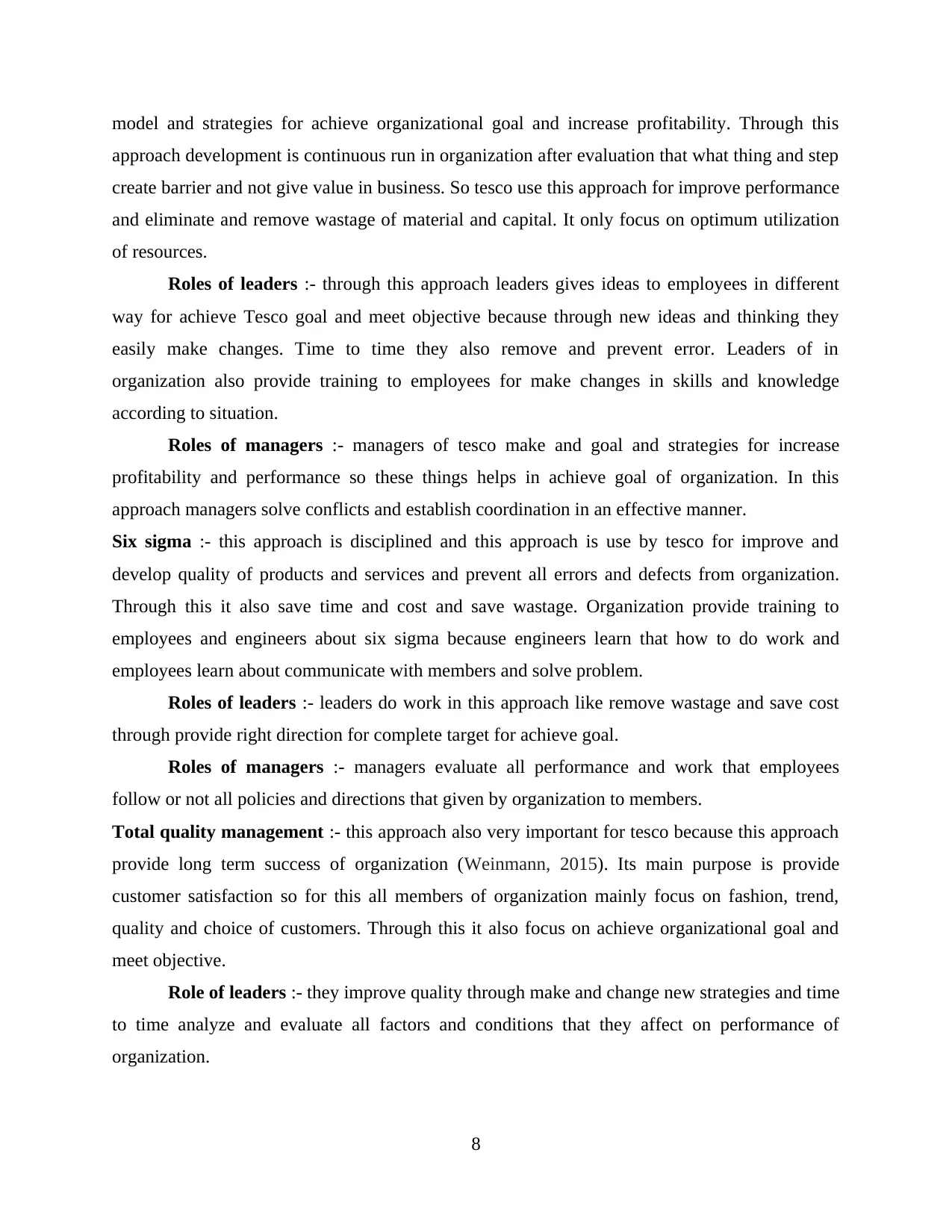
model and strategies for achieve organizational goal and increase profitability. Through this
approach development is continuous run in organization after evaluation that what thing and step
create barrier and not give value in business. So tesco use this approach for improve performance
and eliminate and remove wastage of material and capital. It only focus on optimum utilization
of resources.
Roles of leaders :- through this approach leaders gives ideas to employees in different
way for achieve Tesco goal and meet objective because through new ideas and thinking they
easily make changes. Time to time they also remove and prevent error. Leaders of in
organization also provide training to employees for make changes in skills and knowledge
according to situation.
Roles of managers :- managers of tesco make and goal and strategies for increase
profitability and performance so these things helps in achieve goal of organization. In this
approach managers solve conflicts and establish coordination in an effective manner.
Six sigma :- this approach is disciplined and this approach is use by tesco for improve and
develop quality of products and services and prevent all errors and defects from organization.
Through this it also save time and cost and save wastage. Organization provide training to
employees and engineers about six sigma because engineers learn that how to do work and
employees learn about communicate with members and solve problem.
Roles of leaders :- leaders do work in this approach like remove wastage and save cost
through provide right direction for complete target for achieve goal.
Roles of managers :- managers evaluate all performance and work that employees
follow or not all policies and directions that given by organization to members.
Total quality management :- this approach also very important for tesco because this approach
provide long term success of organization (Weinmann, 2015). Its main purpose is provide
customer satisfaction so for this all members of organization mainly focus on fashion, trend,
quality and choice of customers. Through this it also focus on achieve organizational goal and
meet objective.
Role of leaders :- they improve quality through make and change new strategies and time
to time analyze and evaluate all factors and conditions that they affect on performance of
organization.
8
approach development is continuous run in organization after evaluation that what thing and step
create barrier and not give value in business. So tesco use this approach for improve performance
and eliminate and remove wastage of material and capital. It only focus on optimum utilization
of resources.
Roles of leaders :- through this approach leaders gives ideas to employees in different
way for achieve Tesco goal and meet objective because through new ideas and thinking they
easily make changes. Time to time they also remove and prevent error. Leaders of in
organization also provide training to employees for make changes in skills and knowledge
according to situation.
Roles of managers :- managers of tesco make and goal and strategies for increase
profitability and performance so these things helps in achieve goal of organization. In this
approach managers solve conflicts and establish coordination in an effective manner.
Six sigma :- this approach is disciplined and this approach is use by tesco for improve and
develop quality of products and services and prevent all errors and defects from organization.
Through this it also save time and cost and save wastage. Organization provide training to
employees and engineers about six sigma because engineers learn that how to do work and
employees learn about communicate with members and solve problem.
Roles of leaders :- leaders do work in this approach like remove wastage and save cost
through provide right direction for complete target for achieve goal.
Roles of managers :- managers evaluate all performance and work that employees
follow or not all policies and directions that given by organization to members.
Total quality management :- this approach also very important for tesco because this approach
provide long term success of organization (Weinmann, 2015). Its main purpose is provide
customer satisfaction so for this all members of organization mainly focus on fashion, trend,
quality and choice of customers. Through this it also focus on achieve organizational goal and
meet objective.
Role of leaders :- they improve quality through make and change new strategies and time
to time analyze and evaluate all factors and conditions that they affect on performance of
organization.
8
Paraphrase This Document
Need a fresh take? Get an instant paraphrase of this document with our AI Paraphraser
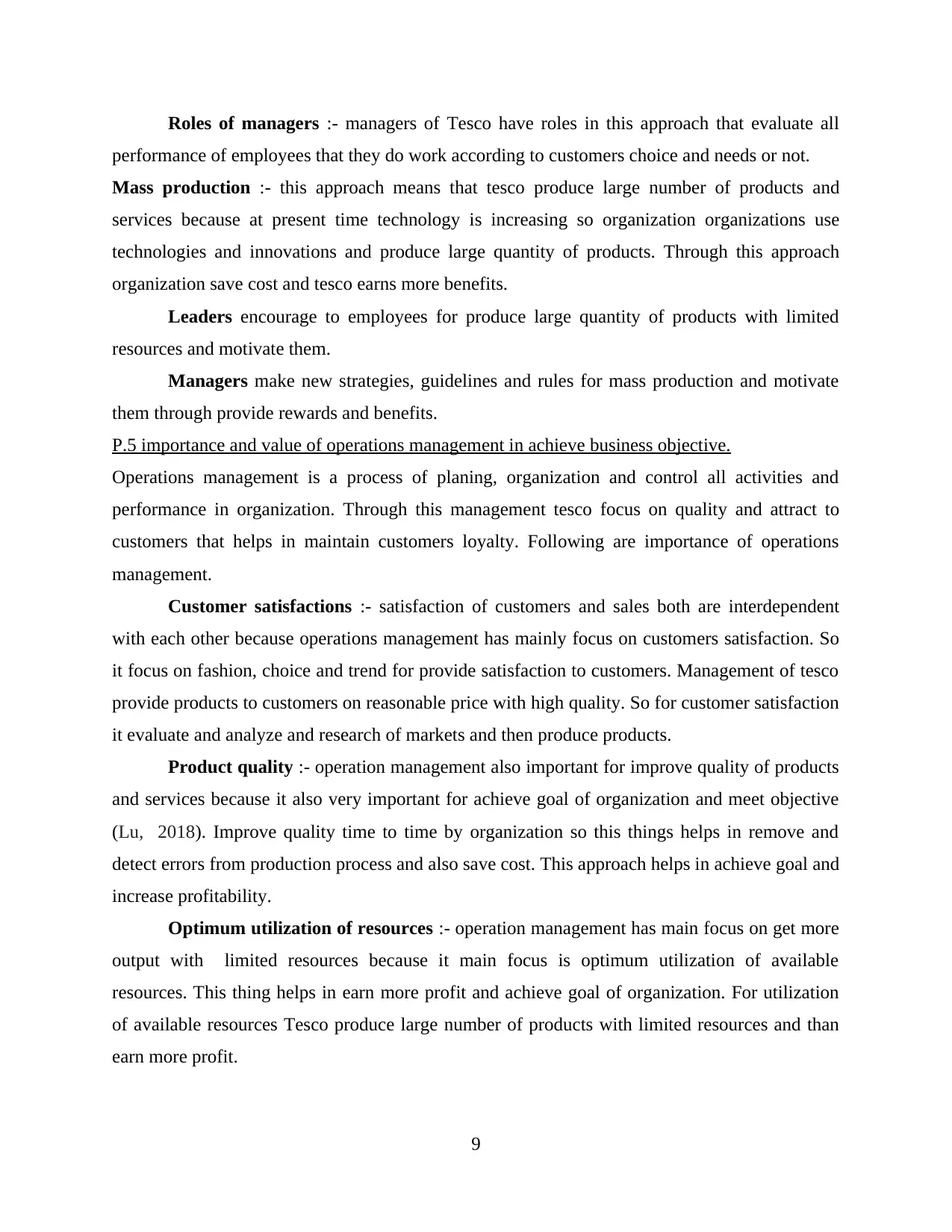
Roles of managers :- managers of Tesco have roles in this approach that evaluate all
performance of employees that they do work according to customers choice and needs or not.
Mass production :- this approach means that tesco produce large number of products and
services because at present time technology is increasing so organization organizations use
technologies and innovations and produce large quantity of products. Through this approach
organization save cost and tesco earns more benefits.
Leaders encourage to employees for produce large quantity of products with limited
resources and motivate them.
Managers make new strategies, guidelines and rules for mass production and motivate
them through provide rewards and benefits.
P.5 importance and value of operations management in achieve business objective.
Operations management is a process of planing, organization and control all activities and
performance in organization. Through this management tesco focus on quality and attract to
customers that helps in maintain customers loyalty. Following are importance of operations
management.
Customer satisfactions :- satisfaction of customers and sales both are interdependent
with each other because operations management has mainly focus on customers satisfaction. So
it focus on fashion, choice and trend for provide satisfaction to customers. Management of tesco
provide products to customers on reasonable price with high quality. So for customer satisfaction
it evaluate and analyze and research of markets and then produce products.
Product quality :- operation management also important for improve quality of products
and services because it also very important for achieve goal of organization and meet objective
(Lu, 2018). Improve quality time to time by organization so this things helps in remove and
detect errors from production process and also save cost. This approach helps in achieve goal and
increase profitability.
Optimum utilization of resources :- operation management has main focus on get more
output with limited resources because it main focus is optimum utilization of available
resources. This thing helps in earn more profit and achieve goal of organization. For utilization
of available resources Tesco produce large number of products with limited resources and than
earn more profit.
9
performance of employees that they do work according to customers choice and needs or not.
Mass production :- this approach means that tesco produce large number of products and
services because at present time technology is increasing so organization organizations use
technologies and innovations and produce large quantity of products. Through this approach
organization save cost and tesco earns more benefits.
Leaders encourage to employees for produce large quantity of products with limited
resources and motivate them.
Managers make new strategies, guidelines and rules for mass production and motivate
them through provide rewards and benefits.
P.5 importance and value of operations management in achieve business objective.
Operations management is a process of planing, organization and control all activities and
performance in organization. Through this management tesco focus on quality and attract to
customers that helps in maintain customers loyalty. Following are importance of operations
management.
Customer satisfactions :- satisfaction of customers and sales both are interdependent
with each other because operations management has mainly focus on customers satisfaction. So
it focus on fashion, choice and trend for provide satisfaction to customers. Management of tesco
provide products to customers on reasonable price with high quality. So for customer satisfaction
it evaluate and analyze and research of markets and then produce products.
Product quality :- operation management also important for improve quality of products
and services because it also very important for achieve goal of organization and meet objective
(Lu, 2018). Improve quality time to time by organization so this things helps in remove and
detect errors from production process and also save cost. This approach helps in achieve goal and
increase profitability.
Optimum utilization of resources :- operation management has main focus on get more
output with limited resources because it main focus is optimum utilization of available
resources. This thing helps in earn more profit and achieve goal of organization. For utilization
of available resources Tesco produce large number of products with limited resources and than
earn more profit.
9
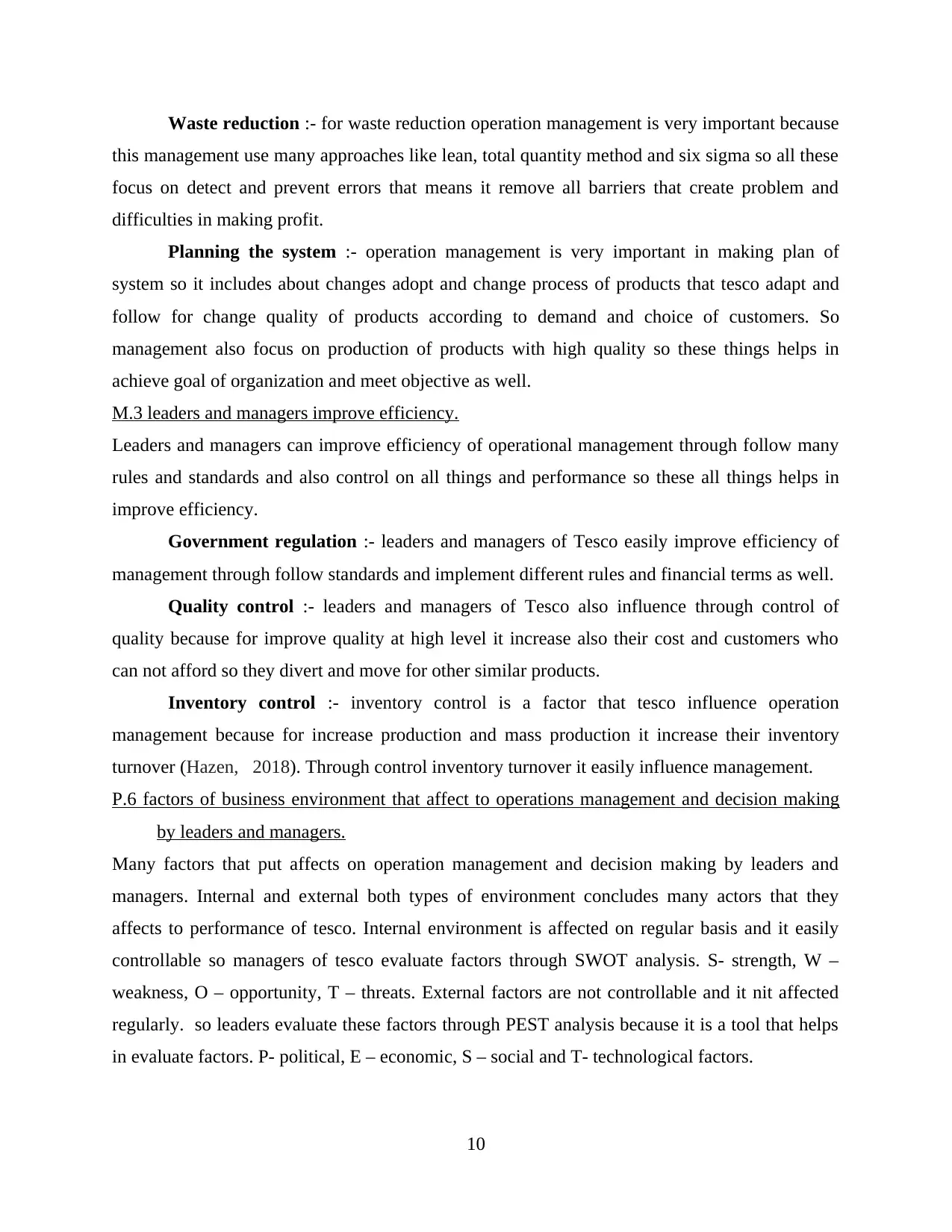
Waste reduction :- for waste reduction operation management is very important because
this management use many approaches like lean, total quantity method and six sigma so all these
focus on detect and prevent errors that means it remove all barriers that create problem and
difficulties in making profit.
Planning the system :- operation management is very important in making plan of
system so it includes about changes adopt and change process of products that tesco adapt and
follow for change quality of products according to demand and choice of customers. So
management also focus on production of products with high quality so these things helps in
achieve goal of organization and meet objective as well.
M.3 leaders and managers improve efficiency.
Leaders and managers can improve efficiency of operational management through follow many
rules and standards and also control on all things and performance so these all things helps in
improve efficiency.
Government regulation :- leaders and managers of Tesco easily improve efficiency of
management through follow standards and implement different rules and financial terms as well.
Quality control :- leaders and managers of Tesco also influence through control of
quality because for improve quality at high level it increase also their cost and customers who
can not afford so they divert and move for other similar products.
Inventory control :- inventory control is a factor that tesco influence operation
management because for increase production and mass production it increase their inventory
turnover (Hazen, 2018). Through control inventory turnover it easily influence management.
P.6 factors of business environment that affect to operations management and decision making
by leaders and managers.
Many factors that put affects on operation management and decision making by leaders and
managers. Internal and external both types of environment concludes many actors that they
affects to performance of tesco. Internal environment is affected on regular basis and it easily
controllable so managers of tesco evaluate factors through SWOT analysis. S- strength, W –
weakness, O – opportunity, T – threats. External factors are not controllable and it nit affected
regularly. so leaders evaluate these factors through PEST analysis because it is a tool that helps
in evaluate factors. P- political, E – economic, S – social and T- technological factors.
10
this management use many approaches like lean, total quantity method and six sigma so all these
focus on detect and prevent errors that means it remove all barriers that create problem and
difficulties in making profit.
Planning the system :- operation management is very important in making plan of
system so it includes about changes adopt and change process of products that tesco adapt and
follow for change quality of products according to demand and choice of customers. So
management also focus on production of products with high quality so these things helps in
achieve goal of organization and meet objective as well.
M.3 leaders and managers improve efficiency.
Leaders and managers can improve efficiency of operational management through follow many
rules and standards and also control on all things and performance so these all things helps in
improve efficiency.
Government regulation :- leaders and managers of Tesco easily improve efficiency of
management through follow standards and implement different rules and financial terms as well.
Quality control :- leaders and managers of Tesco also influence through control of
quality because for improve quality at high level it increase also their cost and customers who
can not afford so they divert and move for other similar products.
Inventory control :- inventory control is a factor that tesco influence operation
management because for increase production and mass production it increase their inventory
turnover (Hazen, 2018). Through control inventory turnover it easily influence management.
P.6 factors of business environment that affect to operations management and decision making
by leaders and managers.
Many factors that put affects on operation management and decision making by leaders and
managers. Internal and external both types of environment concludes many actors that they
affects to performance of tesco. Internal environment is affected on regular basis and it easily
controllable so managers of tesco evaluate factors through SWOT analysis. S- strength, W –
weakness, O – opportunity, T – threats. External factors are not controllable and it nit affected
regularly. so leaders evaluate these factors through PEST analysis because it is a tool that helps
in evaluate factors. P- political, E – economic, S – social and T- technological factors.
10
⊘ This is a preview!⊘
Do you want full access?
Subscribe today to unlock all pages.

Trusted by 1+ million students worldwide
1 out of 16
Related Documents
Your All-in-One AI-Powered Toolkit for Academic Success.
+13062052269
info@desklib.com
Available 24*7 on WhatsApp / Email
![[object Object]](/_next/static/media/star-bottom.7253800d.svg)
Unlock your academic potential
Copyright © 2020–2025 A2Z Services. All Rights Reserved. Developed and managed by ZUCOL.




